2014 SUBARU TRIBECA roof
[x] Cancel search: roofPage 17 of 426

12
Illustrated index
&Exterior
1) Engine hood (page 11-4)2) Headlight switch (page 3-28)3) Bulb replacement (page 11-36)4) Wiper switch (page 3-34)5) Moonroof (page 2-25)6) Roof rail (if equipped) (page 8-14)7) Door locks (page 2-5)8) Tire pressure (page 11-23)9) Flat tires (page 9-6)10) Tire chains (page 8-11)11) Fog light switch (page 3-32)12) Tie-down hooks (page 9-15)13) Towing hook (page 9-15)
Page 91 of 426
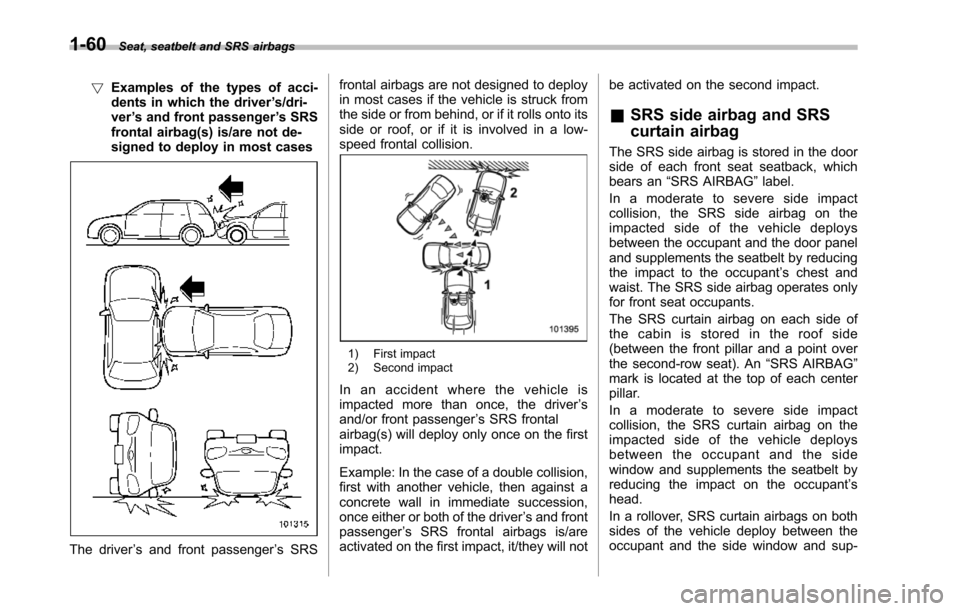
1-60Seat, seatbelt and SRS airbags
!Examples of the types of acci-dents in which the driver’s/dri-ver’s and front passenger’s SRSfrontal airbag(s) is/are not de-signed to deploy in most cases
The driver’s and front passenger’s SRS
frontal airbags are not designed to deployin most cases if the vehicle is struck fromthe side or from behind, or if it rolls onto itsside or roof, or if it is involved in a low-speed frontal collision.
1) First impact2) Second impact
In an accident where the vehicle isimpacted more than once, the driver’sand/or front passenger’s SRS frontalairbag(s) will deploy only once on the firstimpact.
Example: In the case of a double collision,first with another vehicle, then against aconcrete wall in immediate succession,once either or both of the driver’s and frontpassenger’s SRS frontal airbags is/areactivated on the first impact, it/they will not
be activated on the second impact.
&SRS side airbag and SRS
curtain airbag
The SRS side airbag is stored in the doorside of each front seat seatback, whichbears an“SRS AIRBAG”label.
In a moderate to severe side impactcollision, the SRS side airbag on theimpacted side of the vehicle deploysbetween the occupant and the door paneland supplements the seatbelt by reducingtheimpact to the occupant’s chest andwaist. The SRS side airbag operates onlyfor front seat occupants.
The SRS curtain airbag on each side ofthe cabin is stored in the roof side(betweenthe front pillar and a point overthe second-row seat). An“SRS AIRBAG”mark is located at the top of each centerpillar.
In a moderate to severe side impactcollision,the SRS curtain airbag on theimpacted side of the vehicle deploysbetween the occupant and the sidewindow and supplements the seatbelt byreducing the impact on the occupant’shead.
In a rollover, SRS curtain airbags on bothsides of the vehicle deploy between theoccupant and the side window and sup-
Page 92 of 426
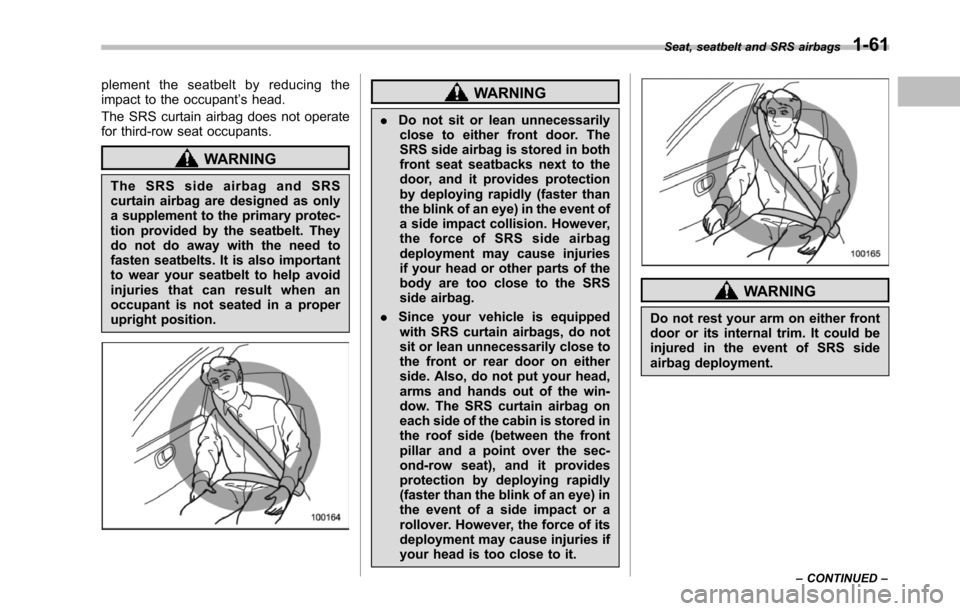
plement the seatbelt by reducing theimpact to the occupant’s head.
The SRS curtain airbag does not operatefor third-row seat occupants.
WARNING
The SRS side airbag and SRScurtain airbag are designed as onlya supplement to the primary protec-tion provided by the seatbelt. Theydo not do away with the need tofasten seatbelts. It is also importantto wear your seatbelt to help avoidinjuries that can result when anoccupant is not seated in a properupright position.
WARNING
.Do not sit or lean unnecessarilyclose to either front door. TheSRS side airbag is stored in bothfront seat seatbacks next to thedoor, and it provides protectionby deploying rapidly (faster thanthe blink of an eye) in the event ofa side impact collision. However,the force of SRS side airbagdeployment may cause injuriesif your head or other parts of thebody are too close to the SRSside airbag.
.Since your vehicle is equippedwith SRS curtain airbags, do notsit or lean unnecessarily close tothe frontor rear door on eitherside. Also, do not put your head,arms and hands out of the win-dow. The SRS curtain airbag oneach side of the cabin is stored inthe roof side (between the frontpillar and a point over the sec-ond-row seat), and it providesprotection by deploying rapidly(faster than the blink of an eye) inthe event of a side impact or arollover. However, the force of itsdeployment may cause injuries ifyour head is too close to it.
WARNING
Do not rest your arm on either frontdoor or its internal trim. It could beinjured in the event of SRS sideairbag deployment.
Seat, seatbelt and SRS airbags1-61
–CONTINUED–
Page 95 of 426

1-64Seat, seatbelt and SRS airbags
right center pillars and rear wheel houses.Another impact sensor, which also sensesimpact force, is located under the second-row center seat. In addition, a rolloversensor is located inside the airbag controlmodule.
If one of the center pillar impact sensorsand the impact sensor that is locatedunder the second-row center seat to-gether sense an impact force above apredetermined level in a side collision, thecontrol module causes both the SRS sideairbag and curtain airbag on the impactedside to inflate regardless of whether therear wheel house impact sensor on thesame side senses an impact. At this time,the driver’s and front passenger’s seatbeltpretensioners also operate at the sametime.
If one of the rear wheel house impactsensors and the impact sensor that islocated under the second-row center seattogether sense an impact force above apredetermined level in a side collision, thecontrol module causes only the SRScurtain airbag on the impacted side toinflate.
If the rollover sensor detects rollover of thevehicle, the control module inflates theSRS curtain airbags. At this time, thedriver’s and front passenger’s seatbelt
pretensioners also operate at the sametime.
After deployment, the SRS side airbagimmediately starts to deflate. The timerequired from detection of an impact todeflation of an SRS side airbag afterdeployment is shorter than the blink ofan eye.
The SRS curtain airbag remains inflatedfor a while following deployment thenslowly deflates.
The SRS side airbag and SRS curtainairbag deploy even when no one occupiesthe seat on the side on which an impact isapplied.
When the SRS side airbag and SRScurtain airbag deploy, a sudden, fairly loudinflation noise will be heard and somesmoke will be released. These occur-rences are a normal result of the deploy-ment. This smoke does not indicate a firein the vehicle.
CAUTION
Do not touch the SRS side airbagsystem components around thefront seat seatback with bare handsright after deployment. Doing so cancause burns because the compo-nents can be very hot as a result of
deployment.
After deployment, do not touch anypart of the SRS curtain airbagsystem (from the front pillar to thepart of the roof side over thesecond-row seat). Doing so cancause burns because the compo-nents can be very hot as a result ofdeployment.
The SRS side airbag and SRS curtainairbag are designed to deploy in the eventof an accident involving a moderate tosevere side impact collision. Also, in thecase of a rollover, the SRS curtain airbagdeploys.They are not designed to deployin most lesser side impacts. Also, they arenot designed to deploy in most frontal ormost rear impacts because SRS sideairbag and SRS curtain airbag deploy-ment would nothelp the occupant in thosesituations.
Each SRS side airbag and SRS curtainairbag are designed to function on a one-time-only basis.
SRS side airbag and SRS curtain airbagdeployments depend on the level of forceexperiencedin the passenger compart-ment during a side impact collision. Thatlevel differs from one type of collision toanother, and it may have no bearing on
Page 97 of 426
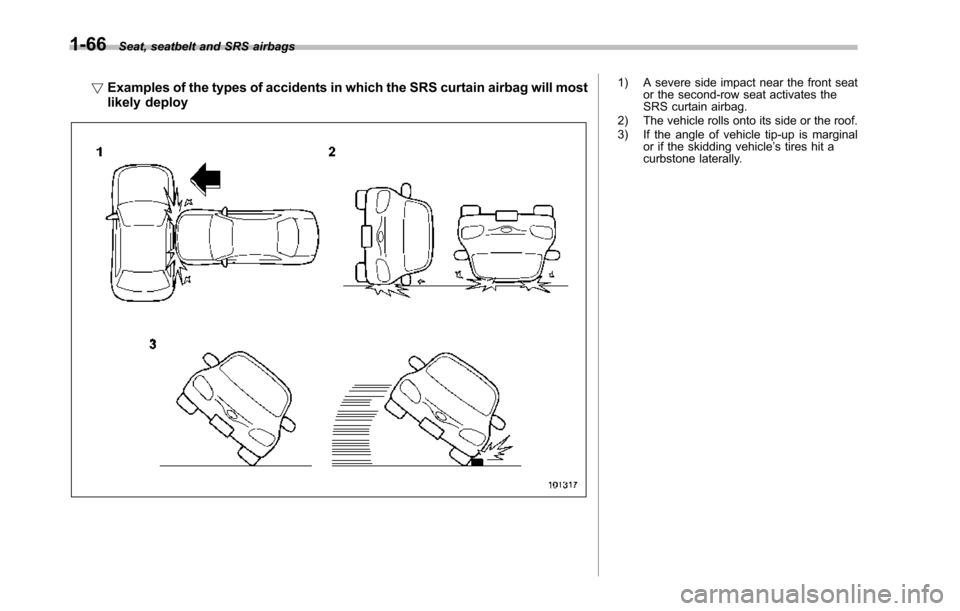
1-66Seat, seatbelt and SRS airbags
!Examples of the types of accidents in which the SRS curtain airbag will mostlikely deploy
1) A severe side impact near the front seator the second-row seat activates theSRS curtain airbag.2) The vehicle rolls onto its side or the roof.3) If the angle of vehicle tip-up is marginalor if the skidding vehicle’s tires hit acurbstone laterally.
Page 99 of 426
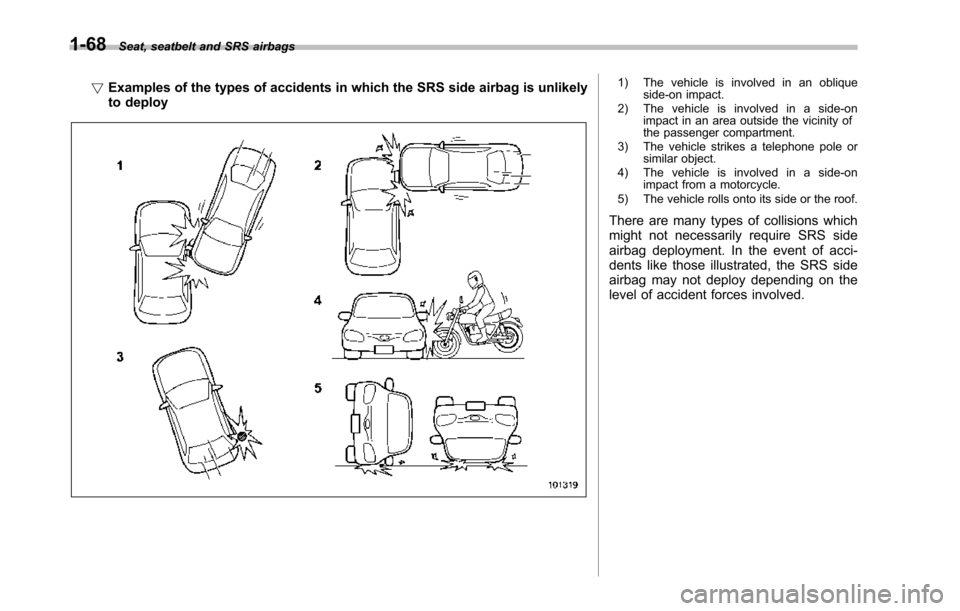
1-68Seat, seatbelt and SRS airbags
!Examples of the types of accidents in which the SRS side airbag is unlikelyto deploy
1) The vehicle is involved in an obliqueside-on impact.2) The vehicle is involved in a side-onimpact in an area outside the vicinity ofthe passenger compartment.3) The vehicle strikes a telephone pole orsimilar object.4) The vehicle is involved in a side-onimpact from a motorcycle.5) The vehicle rolls onto its side or the roof.
There are many types of collisions whichmight not necessarily require SRS sideairbag deployment. In the event of acci-dents like those illustrated, the SRS sideairbag may not deploy depending on thelevel of accident forces involved.
Page 103 of 426
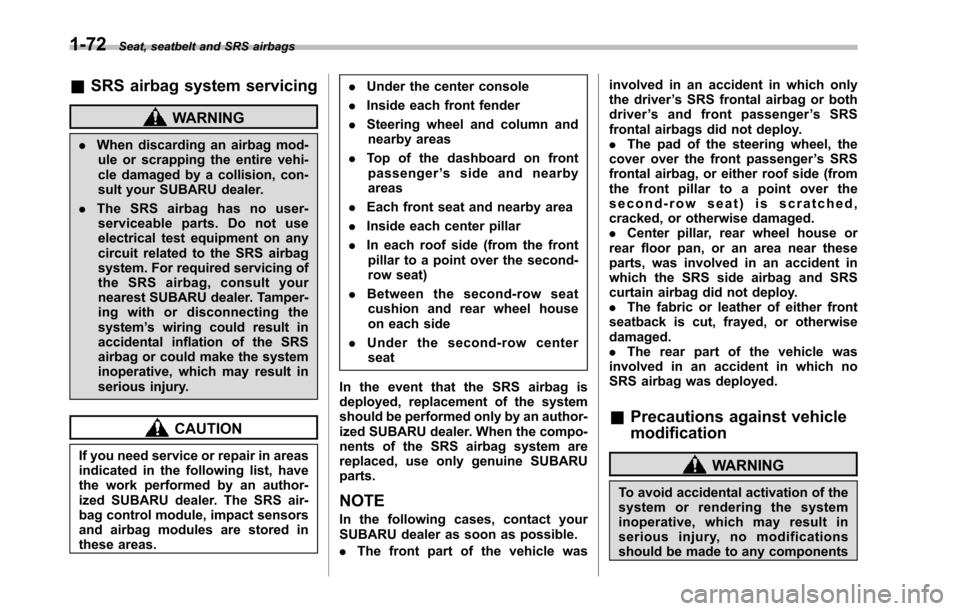
1-72Seat, seatbelt and SRS airbags
&SRS airbag system servicing
WARNING
.When discarding an airbag mod-ule or scrapping the entire vehi-cle damaged by a collision, con-sult your SUBARU dealer.
.The SRS airbag has no user-serviceable parts. Do not useelectrical test equipment on anycircuit related to the SRS airbagsystem. For required servicing ofthe SRS airbag, consult yournearest SUBARU dealer. Tamper-ing with or disconnecting thesystem’s wiring could result inaccidental inflation of the SRSairbag or could make the systeminoperative, which may result inserious injury.
CAUTION
If you need service or repair in areasindicated in the following list, havethe work performed by an author-ized SUBARU dealer. The SRS air-bag control module, impact sensorsand airbag modules are stored inthese areas.
.Under the center console
.Inside each front fender
.Steering wheel and column andnearby areas
.Top of the dashboard on frontpassenger’ssideandnearbyareas
.Each front seat and nearby area
.Inside each center pillar
.In each roof side (from the frontpillar to a point over the second-row seat)
.Between the second-row seatcushion and rear wheel houseon each side
.Under the second-row centerseat
In the event that the SRS airbag isdeployed, replacement of the systemshould be performed only by an author-ized SUBARU dealer. When the compo-nents of the SRS airbag system arereplaced, use only genuine SUBARUparts.
NOTE
In the following cases, contact yourSUBARU dealer as soon as possible.
.The front part of the vehicle was
involved in an accident in which onlythe driver’s SRS frontal airbag or bothdriver’sandfrontpassenger’sSRSfrontal airbags did not deploy..The pad of the steering wheel, thecover over the front passenger’s SRSfrontal airbag, or either roof side (fromthe front pillar to a point over thesecond-row seat) is scratched,cracked, or otherwise damaged..Center pillar, rear wheel house orrearfloor pan, or an area near theseparts, was involved in an accident inwhich the SRS side airbag and SRScurtain airbag did not deploy..The fabric or leather of either frontseatback is cut, frayed, or otherwisedamaged..The rear part of the vehicle wasinvolved in an accident in which noSRS airbag was deployed.
&Precautions against vehicle
modification
WARNING
To avoid accidental activation of thesystem or rendering the systeminoperative, which may result inserious injury, no modificationsshould be made to any components
Page 106 of 426
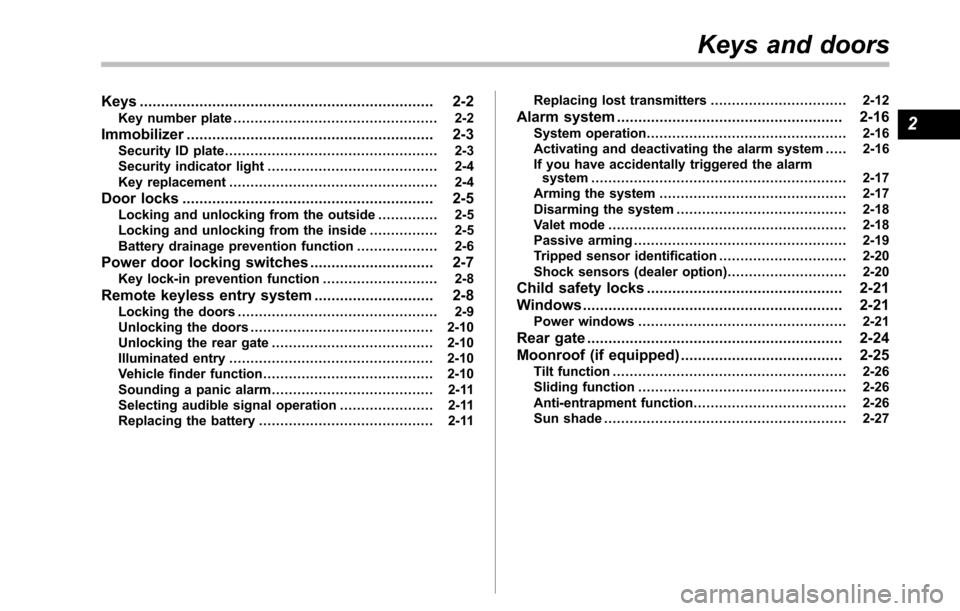
Keys..................................................................... 2-2Key number plate................................................ 2-2
Immobilizer.......................................................... 2-3Security ID plate.................................................. 2-3Security indicator light........................................ 2-4Key replacement................................................. 2-4
Door locks........................................................... 2-5Locking and unlocking from the outside .............. 2-5Locking and unlocking from the inside................ 2-5Batterydrainage prevention function................... 2-6
Power door locking switches............................. 2-7Key lock-in prevention function........................... 2-8
Remote keyless entry system............................ 2-8Locking the doors............................................... 2-9Unlocking the doors........................................... 2-10Unlocking the rear gate...................................... 2-10Illuminated entry................................................ 2-10Vehicle finder function........................................ 2-10Sounding a panic alarm...................................... 2-11Selecting audible signal operation...................... 2-11Replacing the battery......................................... 2-11
Replacing lost transmitters................................ 2-12
Alarm system..................................................... 2-16System operation............................................... 2-16Activating and deactivating the alarm system..... 2-16If you have accidentally triggered the alarmsystem............................................................ 2-17Arming the system............................................ 2-17Disarming the system........................................ 2-18Valet mode........................................................ 2-18Passive arming.................................................. 2-19Tripped sensor identification.............................. 2-20Shock sensors (dealer option)............................ 2-20
Child safety locks.............................................. 2-21
Windows............................................................. 2-21Power windows................................................. 2-21
Rear gate............................................................ 2-24
Moonroof (if equipped)...................................... 2-25Tilt function....................................................... 2-26Sliding function................................................. 2-26Anti-entrapment function.................................... 2-26Sun shade......................................................... 2-27
Keys and doors
2